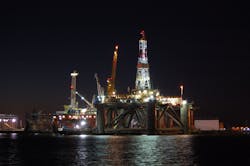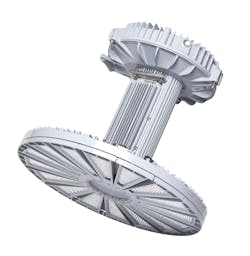Solid-state lighting based on LEDs has seen growing adoption in harsh industrial applications for its high-efficiency operation and long-lasting performance. More durable than conventional lighting and consuming up to 60% less energy, LED fixtures save money on energy and maintenance, plus they provide a more environmentally friendly solution to help achieve company sustainability goals.
Because of its reliability, LED lighting is a safe choice for industrial facility employees. It not only avoids the risk of mercury exposure from broken high-intensity discharge (HID) lamps, but it also offers instant on/off operability across wide ambient temperature ranges and higher-quality illumination with a higher color rendering index (CRI) to improve visibility and reduce the risk of accidents and injuries. The long-life performance of well-made industrial LED light fixtures can also significantly reduce or eliminate the need for dangerous lighting maintenance at high elevation over the lifespan of the fixtures.
However, LED lighting also has some unique vulnerabilities. Because it’s an electronic device, an LED fixture is more sensitive to “dirty power” — fluctuations and anomalies in power supply — than traditional HID fixtures. That means in environments where dirty power is a problem, these fluctuations may prevent companies from taking full advantage of the benefits LED lighting has to offer.
Wanting to avoid ruining your valuable investment in LED fixtures when you know they aren’t completely immune to dirty power is understandable. Facilities can avoid the causes of dirty power wreaking havoc on LED lighting through several steps.
The dirty power dilemma
Dirty power can best be described as abnormalities in the power being delivered to the LED fixture. Ideally, an AC-powered light fixture receives energy in the form of an undistorted sine-wave whose rms voltage is constant. But in reality, this supply may be distorted, undergo significant low or high fluctuations known as sags and swells, and may have voltage transients or surges superimposed on it. High-voltage events due to surges are potentially fatal to LED lighting as well as other unprotected electronic devices.
Heavy industrial 347–480V systems in particular are a warzone for lighting, with high energy surge events created by inductive loads sharing the same circuit, being switched on and off, or unpredictable line-ground voltages created by insulation failures or arcing in ungrounded delta systems, which are prone to large surge events when ground faults occur.
While some dirty power conditions can originate from outside of a facility — caused by excessive load on the power grid itself — 80% of power quality issues are caused by internal issues1, and they contribute to roughly half of mission-critical power outages. As a result of this impact, dirty power can cost anywhere from $14,000 to $6.5 million per hour in downtime costs for a facility, totaling as much as $15 billion in annual expenses1 related to unexpected equipment shutdowns, equipment failures, and maintenance and replacement costs.
All of that is in addition to the risk of accidents and injuries caused by spontaneous lighting failures that plunge facilities into sudden darkness, which could add millions more to the cost in terms of lost time, workers’ compensation claims, and other liabilities.
Dirty power’s impact on lighting
Regardless of the cause of dirty power, the result is the same: When the input power doesn’t match what the device requires, it can cause malfunction, damage, or device failure.
With HID lighting, the problem can manifest itself visually. The lights will dim and surge brightly as large equipment cycles on and off. While HID is relatively tolerant of these fluctuations, they can still cause damage over time, shortening the lifespan of the fixture. In extreme surge events, bulbs can even explode from the power overload, creating a safety hazard from broken glass and mercury exposure for workers in the area.
With LED fixtures, dirty power can cause immediate damage to the fixture. Because the diodes themselves and other power-supply components are electronic devices, they’re more sensitive to power fluctuations than the coil and capacitor ballast of a traditional HID fixture. Where certain dirty power conditions are present, this can cause catastrophic damage to the fixture, negating the long-life and low-maintenance benefits of using LED in the first place.
However, all is not lost. Facilities with dirty power conditions need not suffer with inadequate and inefficient lighting systems. Options exist to quell dirty power problems and allow any facility to experience the benefits of safe, industrial-grade LED lighting.
How to prevail over dirty power on 347–480V systems
Assuming a full system-wide effort to improve power factor, install line reactors, add surge protection devices, or perform other electrical redesign simply isn’t feasible, solutions exist at the luminaire level to help overcome dirty power issues. Three common LED power-supply topologies typically deployed at the luminaire level are switch-mode power supplies rated at full voltage (347–480V; step-down transformers; and “passive” power supplies.
Switch-mode power supplies use transistors that switch off and on at high frequency to temper voltage fluctuations. They are a common and typically robust, efficient solution for an LED luminaire, given stable and predictable power delivery (typically a three-phase, four-wire grounded wye system as one example). While they do provide a higher-efficiency, smaller, and lighter-weight solution, switch-mode power supplies have a distinct disadvantage: They contain a lot of moving parts. Aside from these switches or MOSFETS, many must also include capacitors or inductors for energy storage to offset any dips in power. When exposed to extreme fluctuations, surges, and spikes in dirty-power–prone systems, this power-supply option can be exposed as a weak point given the dearth of semiconductors used in their designs and stress levels imposed by extreme power fluctuations.
Another option is to install a standard 100–277V LED fixture with a traditional, low-frequency transformer added to step down the input power from 480V to 240V. This would allow the LED fixture to operate well within its normal tolerance. However, this adds significantly to the size and weight of the fixture and, again, adds another component that can become a failure point. It also diminishes the overall efficiency of the fixture, once again taking away from the inherent benefits of LED lighting.
However, a passive power supply works like a gatekeeper for incoming power to arrest surges and even out low-voltage conditions to provide steady, “clean” power to the fixture and prevent dirty power damage. Unlike switching and step-down methods, passive solutions have very few components that equal fewer failure points. They offer a high power factor (greater than 0.9) and low total harmonic distortion (THD; less than 20%), and allow facilities to maximize the benefits of high-efficiency LED fixtures (up to 94% efficiency). Because passive power solutions contain no switching components, they offer superior AC surge protection and low internal temperatures, which makes them more reliable and durable even in tough industrial environments. They can also operate at full power at high ambient temperatures without requiring LED thermal roll-off, which also makes for a simpler fixture with fewer components.
Deploying passive power supplies can be an effective strategy in dirty power conditions to protect LED lighting fixtures, but companies must bear two things in mind. First, fixtures with integrated passive power supplies can be larger and heavier than those without, which will be a factor in installation and infrastructure. Second, due to the topology of the power-supply design, controls integration can be somewhat challenging. Basic on/off controls, monitoring, and so on can be supported, assuming the secondary controlling device attached can withstand facility power fluctuations. However, dimming or DALI (Digital Addressable Lighting Interface) controls would not be supported. This makes passive power supplies best suited for 347–480V installations in dirty power environments where lighting is required 24/7 and advanced controls are a secondary concern.
Protecting LED fixtures creates a safer environment
Studies have shown that LED lighting outperforms conventional HID fixtures when it comes to safety and wellbeing of employees in industrial environments. Visual acuity accounts for 85% of perceptual information2 required for employees to make smart, careful decisions in the workplace. Poor lighting has been identified as a leading cause of accidents caused by slips, trips, and falls and contact with objects and equipment — the most common types of workplace incidents second only to transportation accidents3.
Increasing the overall illumination and quality of light has been shown to decrease accident rates by as much as 60%4. And two other studies have proven the efficacy of LED lighting particularly to improve workplace illumination. The Centers for Disease Control and Prevention (CDC) found that LED lighting improved floor tripping hazard detection by nearly 25%, while lowering discomfort and disability glare by roughly 50%. In a second CDC/NIOSH study, workers were able to detect trip hazards 94% faster and peripheral motion 79% faster with the use of LED lighting5.
Furthermore, the higher CRI of LED lighting has shown to improve alertness and reduce fatigue6 dramatically compared to HID solutions, helping to improve workers’ performance and responsiveness7.
These factors combined with the energy efficiency and maintenance cost savings make LED fixtures the safest, most cost-effective, and longest-lasting lighting solution on the market for industrial applications. Facilities with dirty power conditions that have not upgraded to LED lighting are missing out on significant savings while unintentionally jeopardizing workplace safety.
Not all LED luminaires are engineered and manufactured to the same specification, with the same degree of quality or with the same applications in mind. When applying LED luminaires in industrial settings, make sure to investigate the application thoroughly; check the ambient operating temperature at the mounting point; look for potential vibration, humidity, or airborne-contaminant issues; and specify the product accordingly. Be cognizant of what voltage system is present and ask, “Is this an ungrounded system prone to surge events?” and “Is dirty power an issue here?” Although the answers may require some investigation, facilities operators will ultimately be glad they took the extra effort.
By implementing effective dirty-power mitigation solutions appropriate for the unique needs of the industrial environment, companies can take full advantage of the efficiency, safety, and ROI of LED lighting without the risk of damage to their investment.
REFERENCES
1. Schneider Electric, “What is Your PQ IQ?” infographic (2015).
2. C.L. Roth, “Lighting the Way to Safety,” Health & Safety Intl (Sept. 2012).
3. US Dept. of Labor, Census of Fatal Occupational Injuries Summary, Occupational Health and Safety Administration, Mine Safety and Health Administration (2016).
4. O. Abdou, “Effects of Luminous Environment on Worker Productivity in Building Spaces,” J Arch Eng, 3, 3 (Sept. 1, 1997).
5. Centers for Disease Control, National Institute for Occupational Safety and Health.
6. F. Falchi et al., “Limiting the impact of light pollution on human health, environment and stellar visibility,” J Environ Mgt, 92, 10, 2714–2722 (October 2011).
7. L. Edwards and P. Torcellini, National Renewable Energy Laboratory Technical Report, “A Literature Review of the Effects of Natural Light on Building Occupants” (July 2002).
Get to know our expert
SCOTT CHEPKO is vice president of strategic accounts for Dialight, a specialist in heavy-duty industrial LED lighting. He has many years’ experience in contracting, sales, and business development within the lighting and electrical supply sectors. Chepko previously ran a consulting firm providing manufacturer’s representation services in the Carolinas region.
Dialight manufactures industrial lighting for harsh environments.
For up-to-the-minute LED and SSL updates, why not follow us on Twitter? You’ll find curated content and commentary, as well as information on industry events, webcasts, and surveys on our LinkedIn Company Page and our Facebook page.






